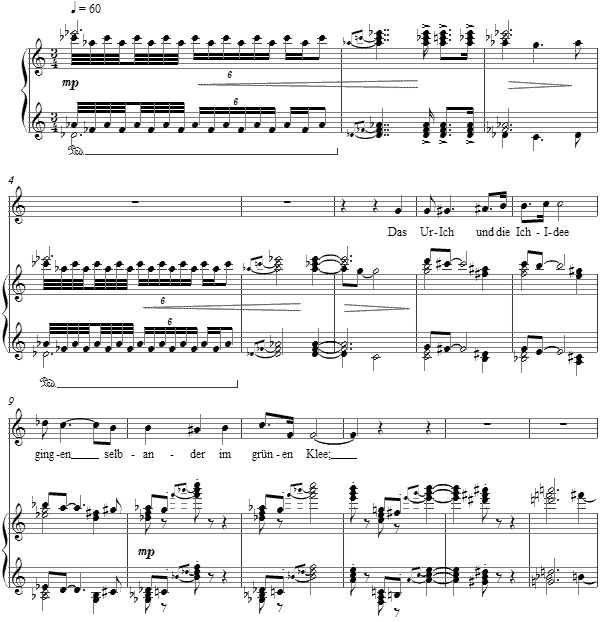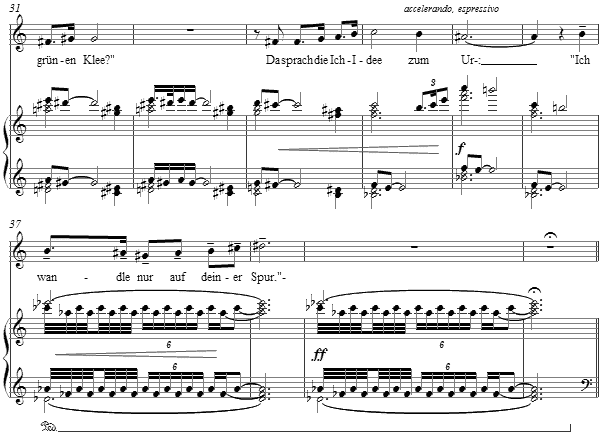Music and Texts of GARY BACHLUND
Vocal Music | Piano | Organ | Chamber Music | Orchestral | Articles and Commentary | Poems and Stories | Miscellany | FAQs
Postskriptum - (2010)
Jakob van Hoddis
for medium voice and piano
Das Ur-Ich und die Ich-idee
gingen selbander im grünen Klee,
Die Ich-Idee fiel hin im Gras,
Das Ur-ich wurde vor Schreck ganz blaß.
Da sprach das Ur- zur Ich-Idee:
"Was wandelst du im grünen Klee?"
Da sprach die Ich-Idee zum Ur-:
"Ich wandle nur auf deiner Spur."-
Da, Freunde, hub sich große Not:
Ich schlug mich gegenseitig tot.[ 3 pages, circa 3' 00" ]
Jakob van Hoddis
The "me" and my "idea of me"
Both strolled through the green clover,
The "idea of me" fell down in the grass,
And the "me" went pale out of shock.
Then the "me" spoke to the "idea of me":
"Why do we stroll in the green clover?"
Then the "idea of me" spoke back to the "me":
"I wander in search of your trace."-
Thus, friends, there came great distress:
I beat myself by agreement between us to death.
Jakob van Hoddis (1887-1942?) was the nom de plume of Berlin-born poet Hans Davidsohn, of which "Van Hoddis" is an anagram. He was influenced, at first, by Stefan George and the Art Nouveau movement, and is thought of as among the founders of the German expressionist movement. As a young adult, he suffered a breakdown and spent successive periods in private and finally public mental hospitals. After Hitler's nomination as Prime Minister in 1933, the Davidsohn family escaped to Tel Aviv but van Hoddis remained in Germany because his mental illness precluded travel documents. As a Jew, an expressionist artist and also mentally ill, his fate was sealed. In 1942 he and all the other patients and staff of his sanatorium were transported to the concentration camp at Sobibór via Krasnystaw; none survived. The date of van Hoddis´ death remains a guess, as it is actually unknown. Poet Else Lasker-Schüler said about van Hoddis´ readings of his work, "His verses are so ardent that one wants to steal them." Much of his work had been published by the groups associated with Berlin's Neu Club: the experimental Sturm, Revolution and the politically radical anthology, Aktion (from which this text of 1913 is drawn), and his own collection, Weltende.
The musical picture of "me" alongside the "idea of me" is drawn through similar gestures separated by the interval of a twelfth. Existing together yet distant, these provide the setting and underpinning of the vocal line, moving alike yet apart. The chromatic slipping of tonal gestures loses an anchor to which tonality underpins this still, essentially tonal work.
The tempo and dynamics rush forward as the "idea of me" seems the one seeking the reality of "me" after which a thunderous set of gestures reach the conclusion -- violence of a sort, as the text declares the proverbial death sentence on both personae in this odd drama of seeking, frustration and conflict within the human ego. That this is a postscript to a life explains the title, and yet the artist who might slay his own ego lives to add such a postscript, for such is sometimes the pursuit of art.
The score for Postskriptum is available as a free PDF download, though any major commercial performance or recording of the work is prohibited without prior arrangement with the composer. Click on the graphic below for this piano-vocal score.


